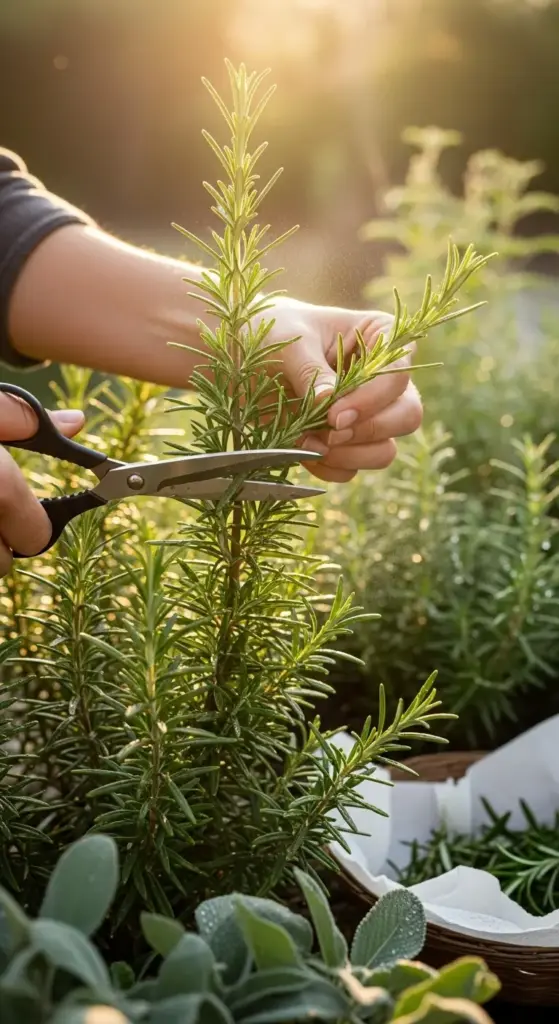6. The Harvesting Timing Technique for Peak Potency

I used to grab rosemary sprigs whenever I needed them for cooking, usually around dinner time when I was already stressed about getting food on the table. Turns out, I was harvesting at literally the worst possible time for flavor.
Everything changed when my chef friend Marco told me about essential oil timing. He said, “You wouldn’t pick tomatoes at night, why would you harvest herbs then?”
The Magic Hour That Changes Everything
Here’s the game-changer: rosemary’s essential oils are most concentrated between 9-11 AM on sunny days. I’m talking about a 40-50% difference in aromatic intensity compared to evening harvests.
The science makes sense once you understand it. Plants produce oils overnight, then the morning sun warms the leaves just enough to concentrate those oils without evaporating them.
By afternoon, especially on hot days, much of that precious oil has literally evaporated into the air. That’s why your garden smells amazing on hot summer afternoons – you’re smelling your harvest potential floating away.
Reading the Weather for Perfect Harvests
Sunny mornings after cool nights are absolute gold for rosemary harvesting. The temperature differential creates maximum oil concentration.
I avoid harvesting on these days:
- Right after rain (oils are diluted)
- During heat waves (oils evaporate too quickly)
- On windy days (stress reduces oil production)
- When plants are drought-stressed
Overcast mornings can actually be perfect too. The oils don’t evaporate as quickly, so you have a longer window for peak harvesting.
The Cutting Technique That Encourages More Growth
I used to just pinch off whatever I needed, wherever I could reach. This random harvesting actually weakens the plant and reduces future yields.
Here’s my strategic cutting method:
Always cut just above a leaf node (where you see tiny leaves emerging). This forces the plant to branch out from that point, creating two stems instead of one.
Make cuts at a 45-degree angle about 1/4 inch above the node. Clean cuts heal faster and prevent disease entry points.
The One-Third Rule for Major Harvests
For big harvesting sessions (like when I’m making rosemary salt or drying herbs for winter), I never take more than one-third of any single stem.
This rule keeps the plant healthy while still giving me plenty to work with. I learned this after nearly killing a beautiful plant by harvesting too aggressively before a dinner party.
Rotate your harvesting around the plant too. Don’t just cut from the most convenient side – spread the harvest evenly to maintain the plant’s shape.
Signs Your Rosemary Is Ready for Major Harvesting
Peak harvest time is usually late spring through early fall, but there are specific visual cues I look for:
- New growth is 4-6 inches long
- Stems feel firm but not woody
- Leaves are deep green and aromatic when brushed
- No flower buds forming (unless you want them)
If the plant looks stressed, has yellowing leaves, or seems to be struggling, I hold off on major harvests and just take what I need for cooking.
The Morning Dew Dilemma
I used to think harvesting with morning dew was bad, but I’ve learned it’s actually fine as long as you handle the herbs properly afterward.
Gently shake off excess water, then lay the sprigs on clean kitchen towels to air dry for 30 minutes before storing. The key is not trapping moisture against the leaves.
Never put wet herbs directly into storage containers – that’s a recipe for mold and rot.
My Harvesting Tool Kit
Sharp kitchen scissors are my go-to tool. They’re cleaner and more precise than garden shears for delicate herb work.
I also keep a clean basket lined with damp paper towels for collecting sprigs. The slight moisture prevents wilting during longer harvesting sessions.
Clean hands are crucial too. I wash them right before harvesting to avoid transferring oils or bacteria to the cut stems.
The Immediate Post-Harvest Window
Here’s something most people don’t know: you have about 30 minutes after cutting before rosemary starts losing significant amounts of essential oils.
For maximum potency, I process my harvest immediately:
- Cooking use: straight into the recipe
- Drying: hung in bundles within 30 minutes
- Freezing: chopped and into ice cube trays with olive oil
This timing makes a huge difference in the final flavor intensity.
Storage Secrets That Preserve Peak Flavor
Fresh rosemary stays potent longest when stored like cut flowers – stems in water, leaves above the waterline, loosely covered with a plastic bag in the fridge.
This method keeps my rosemary fresh and aromatic for 2-3 weeks, compared to maybe 5 days when I used to just throw it in the crisper drawer.
For long-term storage, I’ve found that freezing in olive oil preserves more flavor than traditional drying. The oil protects the essential oils from oxidation.
The Flower Bud Decision
When I see flower buds forming, I have to make a choice. Flowering reduces leaf production and changes the flavor profile slightly.
For cooking herbs, I pinch off flower buds as soon as I see them. For ornamental purposes or bee-friendly gardens, I let about 25% of the stems flower.
Timing matters here too – pinch buds in the morning when the plant has the most energy to redirect into leaf growth.
My Biggest Harvesting Mistakes (Don’t Repeat These)
Mistake #1: Harvesting during the heat of summer afternoons. The herbs wilted before I even got them inside.
Mistake #2: Taking too much from young plants. I stunted their growth for the entire season.
Mistake #3: Using dirty tools and spreading some kind of plant disease between my herbs.
Mistake #4: Storing fresh herbs in sealed plastic bags. Everything turned to mush within days.
The Taste Test That Opened My Eyes
I did a side-by-side comparison of rosemary harvested at different times:
- 9 AM harvest: Intensely aromatic, almost piney
- 2 PM harvest: Noticeably milder, less complex
- Evening harvest: Weak flavor, almost grassy
The difference was so dramatic that I now plan my cooking around optimal harvest times for special dishes.
Seasonal Harvesting Strategies
Spring: Light harvests to encourage growth Summer: Peak harvesting season – go for it Fall: Final major harvest before winter dormancy Winter: Minimal harvesting, let the plant rest
This seasonal approach has dramatically improved both my harvest yields and plant health over the years.
Ready to turn one rosemary plant into an entire herb garden empire? Click “next” to discover The Propagation Mastery Method – these closely guarded techniques will show you how to create unlimited rosemary plants from cuttings, with a success rate that will amaze your gardening friends!









GIPHY App Key not set. Please check settings